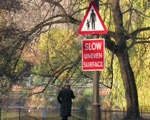 Go to main content
Go to main content
Archive Website of the UK government
Please note that this website has a UK government accesskeys system.
Main menu
Page menu
Disabled people

Mobility scooters and powered wheelchairs for road use

In legal terms, a mobility scooter or powered wheelchair is an 'invalid carriage'. Invalid carriages fall into three categories. Learn more about the different classes, the legal requirements and how to register and license your vehicle (if necessary).
Types of invalid carriages
There are three types of invalid carriages:
Class 1 - manual wheelchairs, that is self-propelled or attendant-propelled, not powered
Class 2 - powered wheelchairs and scooters, primarily for footway use. With a maximum speed of 4 miles (or 6.4 kilometers) per hour and a maximum unladen weight of 113.4 kilograms (250 pounds). Class 2 vehicles must also have an effective braking system and must use lights and reflectors when being used at night.
Class 3 - powered wheelchairs and scooters, for use on roads/highways with a maximum speed of 8 miles (or 12.8 kilometers) per hour. With the facility to limit the maximum speed to 4 mph for use when travelling on footways.
Class 3 vehicles must have:
- a maximum unladen weight of 150 kilograms (330 pounds)
- a maximum width of 0.85 metres (2 feet and nine inches)
- a devide to limit its speed to 4 miles (6.4 kilometers) per hour
- an effective braking system
- front and rear lights and reflectors
- direction indicators which are able to operate as a hazard warning signal
- an audible warning instrument (horn)
- a rear view mirror
- an amber flashing light if it is used on a dual carriageway
If these conditions are not met, you may be prosecuted by the police.
You must register a class 3 vehicle with the Driver and Vehicle Licensing Agency (DVLA).
Where class 2 and 3 vehicles can be used
You can use your class 2 or class 3 vehicle on footpaths, pavements, bridleways and pedestrian areas at a maximum speed of 4 mph. In addition, a class 2 vehicle may be used on a road where there is no footpath available.
Class 3 vehicles can be used on most roads at a maximum speed of 8 mph. They may not be used it on motorways, 'cycles only' cycle lanes or in bus lanes.
You should avoid using a class 3 vehicle on dual carriageways with a speed limit of over 50 mph. If you do use your class 3 scooter or powered wheelchair on a dual carriageway, you must use an amber flashing light for visibility.
Legal requirements
A class 3 vehicle is not legally defined as a motor vehicle. For this reason, the user is not required to have a driving licence or to take a test. You have to be at least 14 years old to drive a class 3 vehicle.
You must not use your scooter or wheelchair if you are under the influence of alcohol, drugs, or medication that may affect your driving ability. If you are in any doubt, consult your doctor.
A class 3 vehicle can only be used by a non-disabled person if that person is:
- demonstrating a vehicle before sale
- training a disabled user
- taking the vehicle to or from a place for maintenance or repair
You do not have to pay Vehicle Excise Duty which is commonly called road tax. You do need to register a class 3 scooter of wheelchair with the DVLA and display a 'nil duty' tax disc. Registration plates are not needed for a class 3 vehicle
You do not have to take out insurance, although it is strongly recommended that you do.
How to register and license a class 3 invalid carriage
New and used class 3 invalid carriages need to be registered for road use, be licensed in the 'disabled' taxation class and display a nil duty tax disc.
Invalid carriages do not need to provide evidence of Vehicle Excise Duty exemption when licensing in the disabled class. They are also exempt from paying the first registration fee.
To register and license a class 3 invalid carriage, you need to complete form V55/5 for used vehicles, or V55/4 for new vehicles. Send the completed form to your nearest DVLA local office. Include evidence of the vehicle's age (if available) and documentation confirming the keeper's name and address. Once your invalid carriage is registered with DVLA, they should send you a 12 month tax disc, before your current tax disc expires.
You cannot license your class 3 invalid carriage at a Post Office branch or by using the Electronic Vehicle Licensing service.
Insurance
Although it is not a legal requirement, an insurance policy is strongly advised. Suitable schemes are available to cover your personal safety, other people's safety and the value of the vehicle.
 Facebook
Facebook Twitter
Twitter StumbleUpon
StumbleUpon Delicious
Delicious Reddit
Reddit